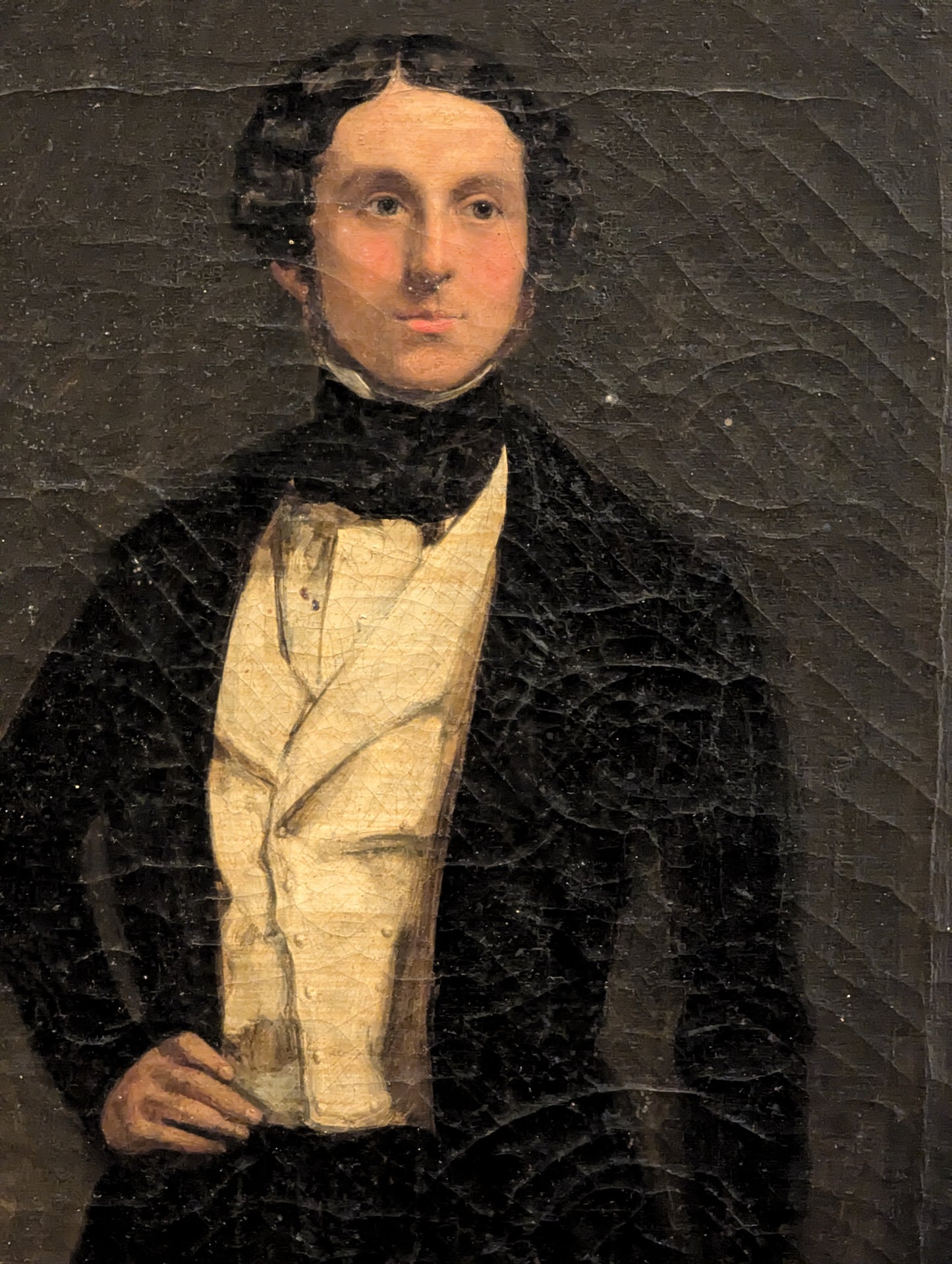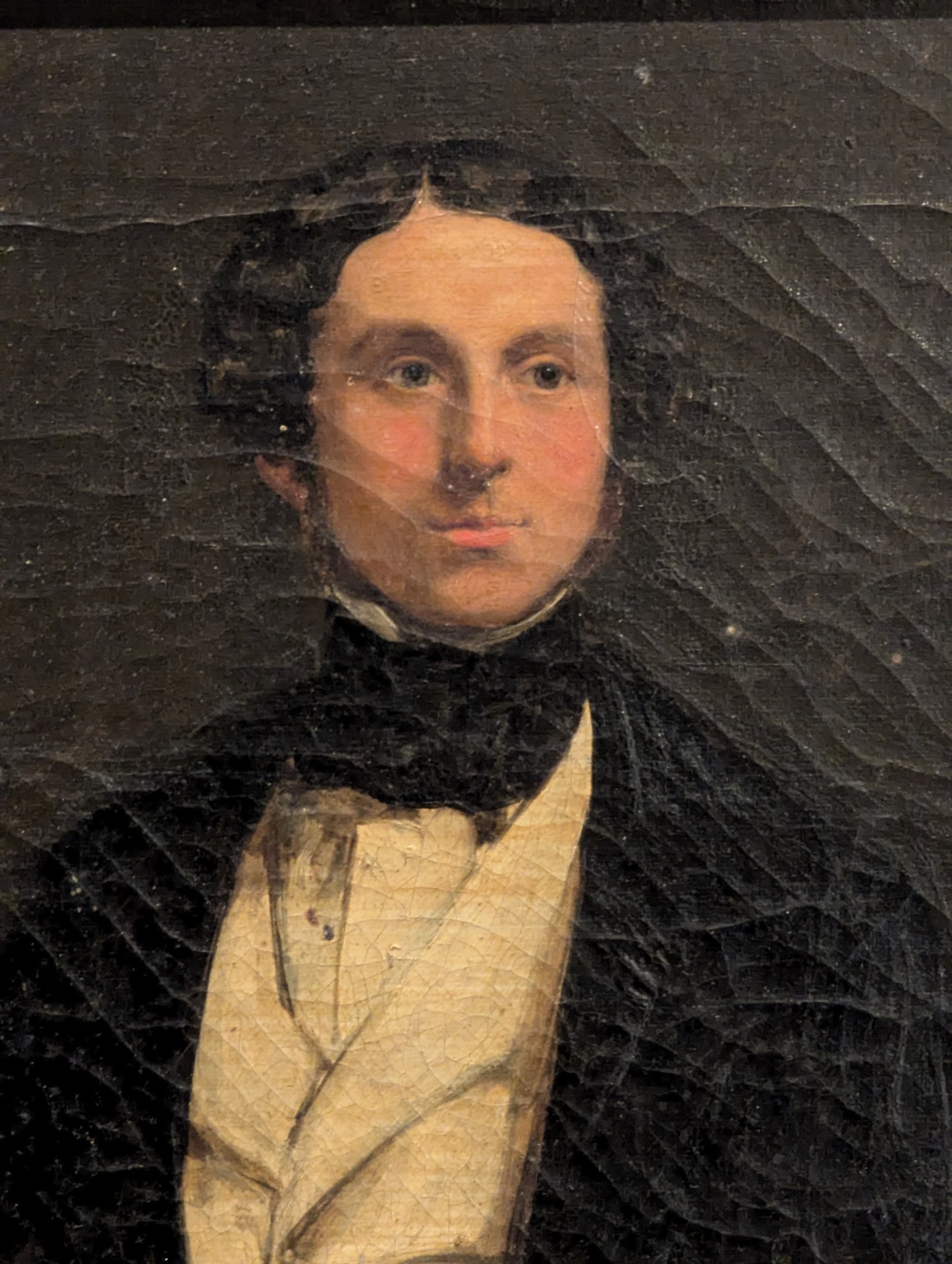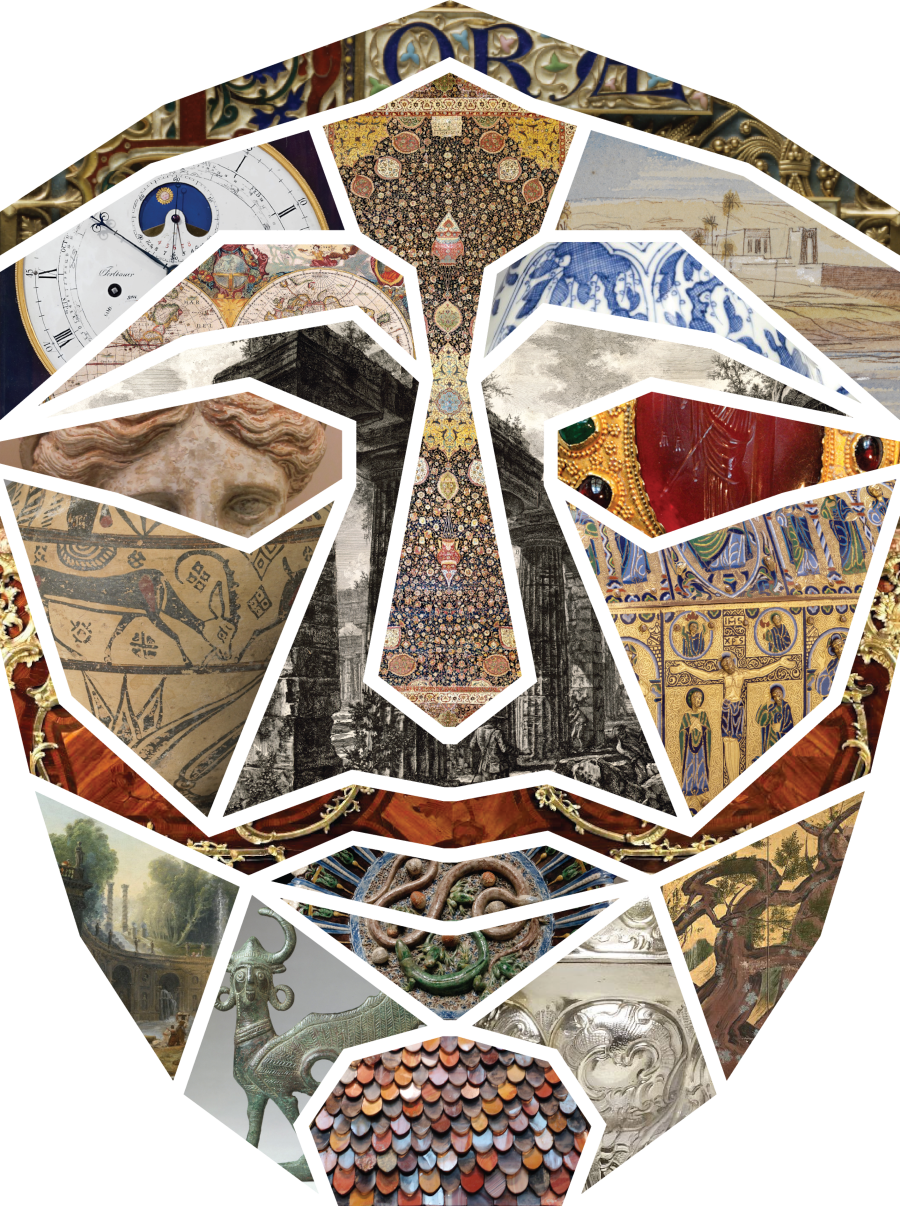My Store
British School Portrait Gentleman Black Silk Stock 1810-1844 - Georgian Victorian Oil
British School Portrait Gentleman Black Silk Stock 1810-1844 - Georgian Victorian Oil
Couldn't load pickup availability
A Fine 3/4 Portrait of a Fashionable Gentleman Wearing a Black Silk Stock, British School, 1810-1844
An exceptional and museum-quality 3/4 portrait depicting a fashionable gentleman wearing a black silk stock, attributed to the British School and dating from 1810-1844. This accomplished oil on canvas portrait (49cm x 39cm) exemplifies the refined portraiture traditions of late Georgian and early Victorian Britain, capturing the sitter's dignified bearing, fashionable dress, and social status with technical skill and psychological insight. The portrait's interesting portable dimensions suggest it was created for personal use during the period just before portrait photography's commercialization around 1842. From an important Anglo-Maltese collection, this portrait represents an excellent acquisition opportunity for collectors of British portraiture, Georgian/Victorian art, or those seeking historically significant works documenting early 19th-century British society.
British School - Artistic Tradition
The attribution to the British School indicates this portrait was created by a competent British artist working within established portraiture traditions but whose specific identity remains unknown. The British School encompasses numerous accomplished portrait painters working throughout Britain during the 18th and 19th centuries, many of whom created fine works for middle and upper-class patrons. These artists maintained high technical standards while working outside the Royal Academy's most celebrated circles. British School portraits document the period's social history, fashion, and artistic practices while offering collectors the opportunity to acquire quality period portraits at more accessible prices than works by named masters.
1810-1844 Dating - Georgian to Early Victorian
The 1810-1844 dating spans a fascinating transitional period in British history and art - from the Regency era (1811-1820) through the accession of Queen Victoria (1837) to the early Victorian period. This era saw tremendous social, political, and cultural changes including the end of the Napoleonic Wars, industrialization's acceleration, and the emergence of Victorian values. The portrait documents this pivotal period's fashions, social customs, and artistic practices. The 1844 terminus ante quem (latest possible date) is significant as portrait photography was commercialized around 1842, after which painted portraits became less common for middle-class patrons.
The Fashionable Gentleman - Subject and Status
The sitter's depiction as a fashionable gentleman wearing a black silk stock indicates his social status and adherence to contemporary fashion. The black silk stock (a type of neckcloth) was standard formal wear for gentlemen during this period, signaling respectability and social position. The 3/4 portrait format - showing head, shoulders, and upper torso - was popular for personal and family portraits, offering more character and presence than bust-length portraits while remaining more affordable than full-length works. The sitter's bearing, dress, and the portrait's quality suggest he was a person of substance - likely a professional, merchant, or member of the gentry.
Black Silk Stock - Fashion Detail
The black silk stock represents an important detail documenting early 19th-century men's fashion. Stocks were stiff neckbands worn around the collar, predecessors to modern neckties. Black silk stocks were particularly fashionable during the Regency and early Victorian periods, associated with formal dress and gentlemanly appearance. The artist's careful rendering of this fashion detail demonstrates attention to contemporary dress and adds historical interest to the portrait. Such details help date portraits and document the evolution of men's fashion.
3/4 Portrait Format - Compositional Choice
The 3/4 portrait format (also called kit-cat size when approximately 36 x 28 inches, though this example is slightly larger) was extremely popular for personal portraits. This format allowed artists to capture the sitter's face, expression, and upper body while including enough context to suggest character and status. The format's popularity reflected its balance between artistic ambition and practical considerations of cost and display. 3/4 portraits work beautifully in domestic settings, creating presence without overwhelming rooms.
Oil on Canvas - Traditional Medium
Executed in oil on canvas, this portrait employs the traditional medium that dominated European portraiture for centuries. Oil paint's versatility allowed artists to achieve subtle flesh tones, rich colors, and fine detail while its slow drying time permitted careful blending and refinement. Canvas provided durable, portable support suitable for portraits of all sizes. The combination of oil and canvas ensured portraits could survive centuries with proper care, as this example demonstrates.
49cm x 39cm - Portable Dimensions
The portrait's dimensions (49cm x 39cm, approximately 19.3 x 15.4 inches) are described as interesting and probably intended for portable use. These relatively compact dimensions made the portrait easy to transport and display in various settings. The portability aspect is particularly significant given the dating to just before photography's commercialization - this portrait may have served functions that photographs would later fulfill, such as keeping loved ones' images while traveling or maintaining family connections across distances.
Craquelure - Age Authentication
The craquelure patterns (fine cracks in the paint surface) are noted as typical of the British School and provide important evidence of the portrait's age and authenticity. Craquelure develops naturally as oil paint ages, with patterns influenced by paint composition, application techniques, and environmental conditions. British School portraits often show characteristic craquelure patterns that help authenticate works and distinguish period paintings from later copies. This age-related craquelure adds character while confirming the portrait's early 19th-century origins.
Pre-Photography Context - Historical Significance
The portrait's creation during the period just before portrait photography's commercialization (around 1842) adds historical significance. For centuries, painted portraits were the only way to preserve likenesses, making them precious family possessions and important social documents. Photography's arrival democratized portraiture but also marked the end of painted portraits' monopoly on image-making. This portrait represents the final generation of painted portraits created before photography transformed visual culture, documenting a pivotal moment in art and social history.
Anglo-Maltese Provenance - Distinguished Collection
The portrait comes from an important Anglo-Maltese collection, adding provenance value and historical interest. Anglo-Maltese families - British families settled in Malta or Maltese families with British connections - often maintained sophisticated art collections reflecting both British and Mediterranean cultural influences. This provenance suggests the portrait has been carefully preserved and valued, while the Anglo-Maltese connection adds layers of cultural and historical interest. Documented provenance significantly enhances value and collecting appeal.
Condition - Honest Assessment
The portrait is described as in good condition, commensurate with age. For a painting potentially 180-210 years old, good condition represents excellent preservation. The craquelure, while adding character and authenticity, doesn't compromise the image's legibility or aesthetic impact. Any condition issues beyond normal age-related changes should be disclosed. Detailed condition reports and conservation assessments available to serious collectors. Appropriate conservation and framing ensure the portrait's continued preservation.
Investment Value and Collectibility
British School portraits from 1810-1844 represent solid investment opportunities in the Old Master and 19th-century art markets. The combination of the portrait's quality, interesting portable dimensions, pre-photography dating, fashionable subject, Anglo-Maltese provenance, and good condition creates appeal among collectors of British portraiture, Georgian/Victorian art, and social history. As authentic period portraits become scarcer and appreciation for British School works grows, quality examples show consistent market performance. The portrait's historical significance as pre-photography work adds investment appeal.
Display and Presentation
This portrait deserves appropriate framing and placement where its historical significance and artistic quality can be appreciated. Period or period-style frames enhance authenticity while proper hanging in stable environmental conditions ensures preservation. The portrait works beautifully in traditional interiors - libraries, studies, dining rooms, or hallways - where it contributes to atmosphere while documenting early 19th-century British culture. The portable dimensions make it suitable for various settings and easy to relocate as needed.
Cultural and Historical Significance
This portrait embodies early 19th-century British portraiture traditions, documents Georgian/early Victorian fashion and social customs, and represents the final generation of painted portraits before photography's arrival. It connects viewers to this pivotal period in British history while demonstrating portraiture's role in preserving memory, documenting status, and creating family heritage. The portrait invites contemplation of how people presented themselves, what they valued, and how visual culture has evolved.
Collecting Context
This portrait appeals to collectors of British School paintings, Georgian/Victorian portraiture, pre-photography art, men's fashion history, Anglo-Maltese cultural materials, and those seeking historically significant works documenting early 19th-century British society. It would enhance private collections, corporate holdings emphasizing British heritage, or institutional settings where the work can contribute to understanding of portraiture history and social customs.
Available for viewing by appointment at Artemisia Fine Arts & Antiques Ltd, Malta. We provide expert consultation, condition assessment, conservation coordination, provenance research, insurance valuation, and international shipping with specialized fine art handlers. This British School portrait represents an exceptional acquisition opportunity. Serious inquiries from qualified collectors welcome.
Share






